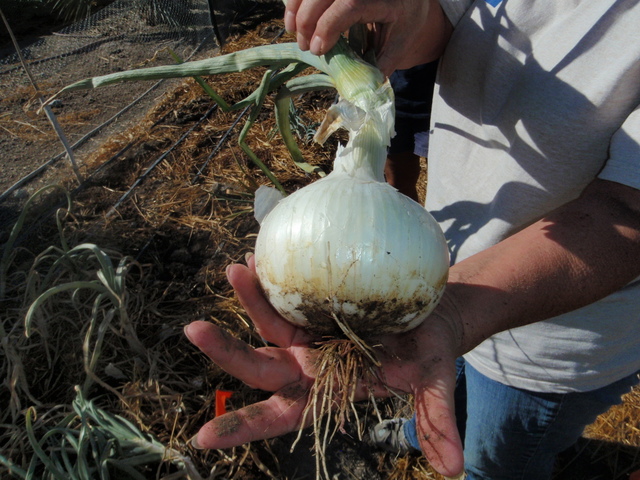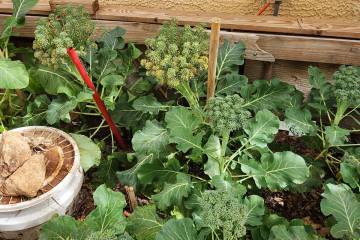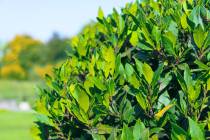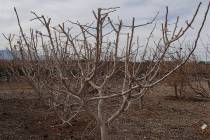Cooler weather means it’s time to clean up the yard
Reading some of the national gardening blogs and articles gives me a chuckle. Frequently they are out of touch with gardening and horticulture in the desert Southwest. For instance, one recently said there was little to do during the winter months. Obviously, they have never lived in our climate.
I am very particular about sanitation. Sanitation of the garden, sanitation of the fruit trees, sanitation of tools, they are all important. The garden area must be clean enough to host a Sunday meal.
Clean up the garden area. Sanitation of the garden area starts by picking up debris left behind from our summer vegetables. Leaving these behind gives overwintering and hiding spots for mature insects that can repopulate the garden quickly in the spring.
Diseases that still reside on residue, although dormant, left behind after harvesting our summer crops will be given a second chance to hurt winter or spring crops as they emerge.
Diseases like these cannot be seen. Moving planting areas into different garden spots each year reduces future disease problems. Tomatoes, for instance, should not be planted where tomatoes or even peppers or eggplants were planted last year. Plant something different in those spots for the next couple of years.
Remove dead fruit still clinging to the trees. It may not look tasty to us, but it looks really yummy to insects and diseases. Remove and dispose of mummified fruit.
Remove weeds. I have seen aphids huddled at the base of weeds just under the soil surface where it’s warmer and out of the wind. They don’t move around much when it’s cold, but when the day warms up they find tender plant parts above ground that are easy to feed on and move back to those protected areas when temperatures begin to cool.
A very interesting thing happens with insects, diseases and weeds during the fall in our temperate climate. Whether it’s because of the cooling of seasonal air temperature or the shortening of our days or both, many sense that winter is approaching. This causes a biological shift from reproduction to winter survival.
This is an excellent time to be on the attack regarding garden pests because they are on the retreat. If you go out to your lettuce, spinach, greens, chard and other winter leafy greens and look at the bottoms of the leaves I will bet they will be full of bugs.
Now is a great time to spray the bottoms of leaves with insecticidal soap or oils. The pyrethrum sprays will give you very effective control. Spray when temperatures are warm and there’s no wind.
Systemic weed killers such as Roundup work most effectively now when the plant is sending food reserves into winter storage. A light spray covering the leaves and remaining on the leaves for 12 hours is enough. After 12 hours, feel free to remove the tops since the systemic has now moved into the roots and will continue to kill.
Q: After reading your list of recommended fruit trees I see that Fuji apple trees would do well in Las Vegas.
A: Yes, they will do well. Don’t expect to get the same quality of Fuji apple you might when grown in cooler climates. The tree, as well as the fruit itself, will respond differently in our climate because of higher light intensity, temperatures, lower humidity and our alkaline soils. Apples grown in our climate tend to have a thicker skin and more wax development on the outside.
Expect to get fruit with a higher sugar content and less acidity. The fruit may not be first-class but it will be better than what you’re buying in the grocery store.
Most tree fruit is harvested too early, mature enough to meet the minimum requirements by the buyer but not fully ripened. You have the luxury of leaving the fruit longer on the tree where it will develop more sugar and flavor.
Q: I have many different plants in my yard including roses, iris, sumac, mesquite, a couple of fruit trees, shrubs like xylosma, photinia, Texas rangers and many others. Is there a single fertilizer I could use to fertilize all of them? And do I have to fertilize them at different times or can I fertilize them all at once?
A: This is a difficult question because it could have an array of different answers depending on the owner. Fertilizer applications are dependent on the expectations of the owner.
The higher the expectations are from these plants the more complicated the fertilizer application. If the expectations are relatively low, you want a generally good-looking landscape but are not into high-performance, then the fertilizer program is less complicated.
Generally speaking, only two or three types of fertilizers are necessary: high nitrogen, high phosphorus and all-purpose. These fertilizers will get you by with a single application per year for most plants, with high-value plants receiving two to three applications per year.
High nitrogen fertilizers are used most often because they continuously push new growth. If you want leaves and stems, use a high nitrogen fertilizer. These fertilizers might be applied up to three or four times each season depending on the value of the plant. Examples of high nitrogen fertilizers include 21-7-14, 16-6-8, 21-0-0.
High phosphorus fertilizers are used less often but at very specific times: planting time, just before flowering and for fruiting plants. Typically, high phosphorus fertilizers are applied only once during the year because phosphorus stays in the soil for a long time. Examples of high phosphorus fertilizers include 16-20-0, 18-46-0, 0-45-0.
All-purpose fertilizers are just what the name implies; they are not applied for any specific purpose but generally used as a “pick me up” when a general fertilizer application is needed.
If you are going to make one application to all plants growing in a landscape, do it in late winter or early spring (January/February). This single application will get you by. If you are to make three applications in a single year then make them in late January, April/May and the third in October/November when growth has stopped for the season.
Bob Morris is a horticulture expert living in Las Vegas and professor emeritus at the University of Nevada. Visit his blog at xtremehorticulture.blogspot.com. Send questions to Extremehort@aol.com.





























